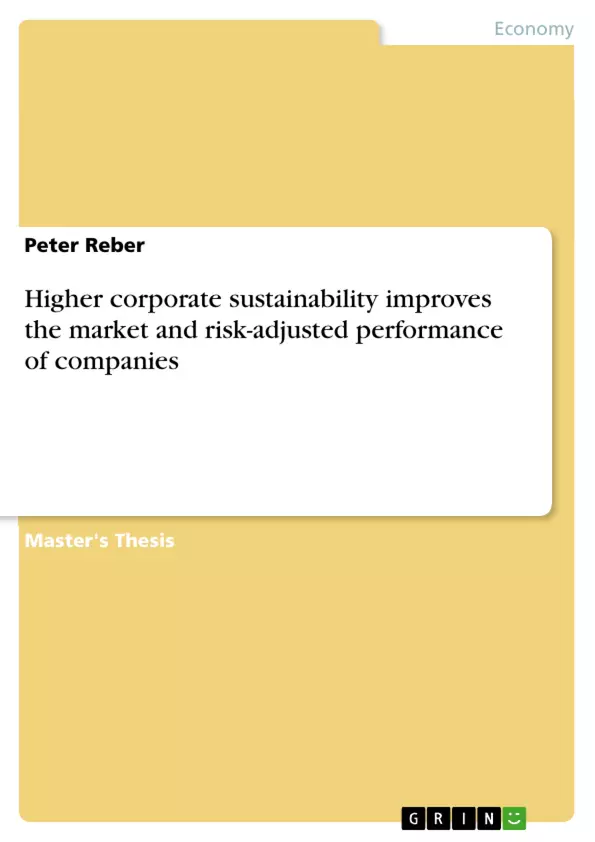This project complements previous empirical research on the study of sustainability, market and risk-adjusted performance by employing to date unused data.
Sustainability provides opportunities for producers to lower costs, for entrepreneurs and investors to increase profit; and therefore should have an impact on the market performance. Whether sustainability has an impact on market and risk-adjusted performance is examined using three indexes - the Dow Jones Sustainability World Index, the Dow Jones Global Index and the Dow Jones Global Total Stock Market Index. As the most sustainable companies from the Dow Jones Global Stock Market Index are included in the Dow Jones Sustainability World Index, it is expected that the index with more sustainable companies would show a better market and risk-adjusted performance.
The study`s results provide no evidence that there is a generic business case for sustainability. The insignificant, slightly higher performance of DJSIW seems to come with additional volatility and risk, as this index shows the lowest Sharpe Ratio of the three indexes. The study indicates that companies with remarkable sustainable development strategies are not more likely to be rewarded by investors with a higher valuation in the financial markets and do not show a better risk-adjusted performance.
Inhaltsverzeichnis (Table of Contents)
- Abstract
- Acknowledgements
- Table of Contents
- List of Figures
- List of Tables
- List of Abbreviations
- List of Appendices
- Dedication
- Chapter 1: Overview
- 1.1. Definitions
- 1.2. Problem Statement
- 1.3. Purpose
- 1.4. Significance of the Study
- 1.5. Nature of the Study
- 1.6. Research Questions and Hypotheses
- 1.6.1. Research question 1
- 1.6.2. Hypothesis 1 (1H): return
- 1.6.3. Research question 2
- 1.6.4. Hypothesis 2 (2H): return
- 1.6.6. Research question 3
- 1.6.7. Hypothesis 3 (3H): risk
- 1.6.8. Research question 4
- 1.6.9. Hypothesis 4 (4H): risk
- 1.7. Variables
- 1.8. Theoretical Framework
- 1.9. Scope and Limitations
- Chapter 2: Foundations of Project Design
- 2.1. Literature Review
- 2.2. Research Design
- 2.3. Sampling Methods and Procedures
- 2.3.1. Population
- 2.3.2. Data collection methodology
- 2.4. Validity
- 2.4.1. External validity
- 2.4.2. Instrument reliability
- 2.5. Methodology Appropriateness
- 2.6. Collection of Data
- 2.7. Analysis of Data
- Chapter 3: Action Plan
- 3.1. Hypothesis 1
- 3.1.1. Descriptive and graphical analysis
- 3.2. Hypothesis 2
- 3.3. Hypothesis 3
- 3.3.1. Descriptive and graphical analysis
- 3.4. Hypothesis 4
- 3.1. Hypothesis 1
- Chapter 4: Discussions and Conclusions
- 4.1. Conclusions about the Research Questions
- 4.2. Conclusions from Data Analysis
- 4.3. Hypotheses & Null Hypothesis
Zielsetzung und Themenschwerpunkte (Objectives and Key Themes)
This project aims to analyze the relationship between corporate sustainability and company performance, particularly focusing on market and risk-adjusted performance. The study utilizes previously unused data to complement existing empirical research on sustainability and financial performance. It seeks to determine whether companies with higher levels of sustainability demonstrate improved performance compared to their less sustainable counterparts.
- The impact of corporate sustainability on market performance.
- The relationship between sustainability and risk-adjusted performance.
- The use of multiple indexes to measure sustainability and performance.
- The investigation of a potential generic business case for sustainability.
- The role of investor valuation in rewarding companies with sustainable development strategies.
Zusammenfassung der Kapitel (Chapter Summaries)
Chapter 1 provides an overview of the project, defining key terms, outlining the problem statement, and establishing the purpose and significance of the study. It also details the research questions and hypotheses, including variables and the theoretical framework. Chapter 2 delves into the foundations of the project design, reviewing relevant literature, outlining the research design, and discussing sampling methods and procedures. It also addresses the validity and appropriateness of the methodology employed. Chapter 3 presents the action plan, focusing on the analysis of each hypothesis, utilizing descriptive and graphical analyses where applicable. Finally, Chapter 4 discusses the conclusions derived from the study, examining the research questions, data analysis, and hypotheses in relation to the null hypothesis.
Schlüsselwörter (Keywords)
This project explores the relationship between corporate sustainability and company performance, focusing on market and risk-adjusted performance. Key areas of focus include sustainable development strategies, investor valuation, financial markets, risk assessment, and the use of multiple indexes such as the Dow Jones Sustainability World Index, Dow Jones Global Index, and Dow Jones Global Total Stock Market Index. The study investigates the potential existence of a generic business case for sustainability, analyzing whether companies with higher levels of sustainability demonstrate improved performance compared to their less sustainable counterparts.
- Quote paper
- Peter Reber (Author), 2013, Higher corporate sustainability improves the market and risk-adjusted performance of companies, Munich, GRIN Verlag, https://www.grin.com/document/943757



